Abstract
Background:
Depression is a major cause of suicide worldwide. This association has been reflected by numerous scientific publications reporting about studies to this theme. There is currently no overall evaluation of the global research activities in this field.
Aim:
The aim of the current study was to analyze long-term developments and recent research trends in this area.
Material and Methods:
We searched the Web of Science databases developed by the Thompson Institute of Scientific Information for items concerning depression and suicide published between 1900 and 2007 and analyzed the results using scientometric methods and density-equalizing calculations.
Results:
We found that publications on this topic increased dramatically in the time period 1990 to 2007. The comparison of the different Journals showed that the Archives of General Psychiatry had the highest average citation rate (more than twice that of any other Journal). When comparing authors, we found that not all the authors who had high h-indexes cooperated much with other authors. The analysis of countries who published papers on this topic showed that they published papers in relation to their Gross Domestic Product and Purchasing Power Parity. Among the G8 countries, Russia had the highest male suicide rate in 1999 (more than twice that of any of the other G8 countries), despite having published least papers and cooperating least with other countries among the G8.
Conclusion:
We conclude that, although there has been an increase in publications on this topic from 1990 to 2006, this increase is of a lower gradient than that of psoriasis and rheumatoid arthritis.
Keywords: Bibliometric, depression, suicide
INTRODUCTION
During the times of ancient Rome, suicide was seen as a honorable way to die. Ship captains would commit suicide if they lost their ships and admirals would kill themselves when they lost a battle, rather than to face the humiliation of going home in defeat. This is nicely portrayed in the blockbuster movie “Ben Hur,” when the main character prevents an admiral from killing himself when he loses his ship in a battle, only to find out that they actually won the battle. This tendency of “honourable suicide” went even further in those days, as wealthy citizens would have a big party to celebrate the fact that they were going to kill themselves. Suicide has also been used as an “honourable” way to kill other people. This way of thinking was evident among the Japanese kamikaze pilots in World War II, where the pilots would fly their planes into allied battle ships. Unfortunately, this thinking pattern still persists in the 21st century, as was so clearly seen in the tragic events of September 11, 2001.[1]
From the amount of papers published on suicide over the last century, it is clear that this opinion is not shared by the majority of researchers. Suicide is seen as something that we want to prevent, a condition that goes against a deep conviction of the value of life. This is a view that is expressed by the World Health Organisation (WHO) mental health gap action program, in which services for the prevention of suicide (among others) are offered to countries with low to middle income.[2] Beyond the humanistic reasons to prevent suicide, there is clear evidence of the dangers of suicide to society. Suicide can be a major financial burden for a country, as suicide attempts cost the US government approximately $581 million on hospitalization in 1994,[3] and suicide was the fourth leading cause of Years of Professional Life Lost (YPLL) in the USA in 2002.[4] Suicide can also be a medical problem as it rated as the fourth leading cause of death among men in the middle ages of life.[5] The burden of suicide to a country also has an impact on the next generation, as the suicide rate among youths in the US has tripled from 1950 to 2002.[6] As a result of the evidence of the impact of suicide on society, suicide prevention was regarded as a national priority in the USA in the 21st century in the President's New Freedom Commission on mental health in 2002.[7]
95% of people who commit suicide or attempt to commit suicide are diagnosed with a mental disorder, with depression being the number one cause of suicide in mental health, making up almost 80%.[8] Depression is clearly a major factor in suicide as two-thirds of depressed patients contemplate suicide, 10 to 15% of depressed patients commit suicide,[9] and more than 50% of people who die as a result of suicide meet the criteria for a depressive disorder.[10] In the criteria for a depressive disorder, suicide is regarded as a risk factor in both the International Classification of Diseases and behavioural Disorders (ICD) 10 classification of mental and behavioral disorders[11] as well as in the Diagnostic and statistical manual of mental disorders (DSM IV TR).[12] In a major depressive disorder, patients are most likely to commit suicide during their first episode.[13] Depression as a contributory factor to suicide is not just limited to major depressive disorder. In patients with bipolar affective disorder who commit suicide, depressive symptoms (including hopelessness) are regarded as risk factors.[14] It has also been shown that the risk of suicide in schizophrenia is more associated with depression and specific affective symptoms (like agitation, a sense of worthlessness and hopelessness), rather than with the core symptoms of schizophrenia (like delusions and hallucinations).[15]
In the context of the above evidence that there is a close relation between suicide and depression, the question arose as to how much research has been published in the last century in which both depression and suicide were core subjects? We were also interested in which journals published most papers on these subjects and what the average citation rates of these journals were. Similarly, we wanted to compare the authors who published most papers with regard to their h-indexes and the amount of cooperation between them. Furthermore, we wanted to investigate the countries of origin of the publications, whether their gross domestic product (GDP) and purchasing power parity (PPP) had any influence and what the cooperation was between the countries that published most papers. Lastly, we wanted to compare the G8 countries by comparing the amount of publications with the known suicide rates of these countries.
MATERIALS AND METHODS
Data source
The data for this study was retrieved from the database Web of Science (WoS) from the Thomson Institute for Scientific Information (ISI).[16,17]
Search strategies
The phrase “depression* AND suicide*” was used in order to include all publications about depression and suicide. The Boolean operator “AND” was used to limit the search to publications which addressed both subjects simultaneously. The asterisk was included in order to replace the word endings in order to encompass all possible endings.
Time span
The analyzed time span was restricted to the period 1900-2007, as we only wanted to compare completed years.
Citation quantities
The “citation report” function was used in order to analyze publications. It uses the result of the frequency of which a publication is cited and divides it by the number of results found. In this way, the amount of times a specific Journal or author was cited could be analyzed as an indicator of research quality. The following citation databases were used:
Science Citation Index Expanded (SCI-EXPANDED)-1900 to present
Social Sciences Citation index (SSCI)—1956 -present
Arts and Humanities Citation Index (A and HCI)—1975-present
H-index
As a further measure of publication quality, the h-index (developed by Hirsch JE) was used.[18] If an author has an h-index of 6, he has published at least 6 papers which have each been cited at least 6 times by other authors.
Density-equalizing mapping
In this method, specific calculations based on Gastner and Newman's algorithm[19] were used in order to produce a map of the world in which the different countries were sized according to specific variables, in this case the amount of publications on depression and suicide published by that country.
Gross domestic product and purchasing power parity
The GDP gives an indication of the “income” of a country, whereas the PPP gives an indication of what one can buy with 1 $US in the USA, compared with (for example) 1 $US in India. For more information on the GDP and PPP, please see the International Monetary Fund.[20] The data for the GDP were taken from the World Bank[21] and the data for population of the different countries were taken from the World health organization.[22]
RESULTS
Total number of publications
In Figure 1, the total number of publications relating to the subjects of depression and suicide (according to the WoS) from 1900 to 2007 is shown, as an indication of the amount of research that has been published on this topic during this time period. This topic slowly increased in importance over the 20th century, with the amount of publications per year rising slowly from 1 to 29 between 1901 and 1990. There is then an increase that reaches up to 578 in 2006 and 500 in 2007.
Figure 1.
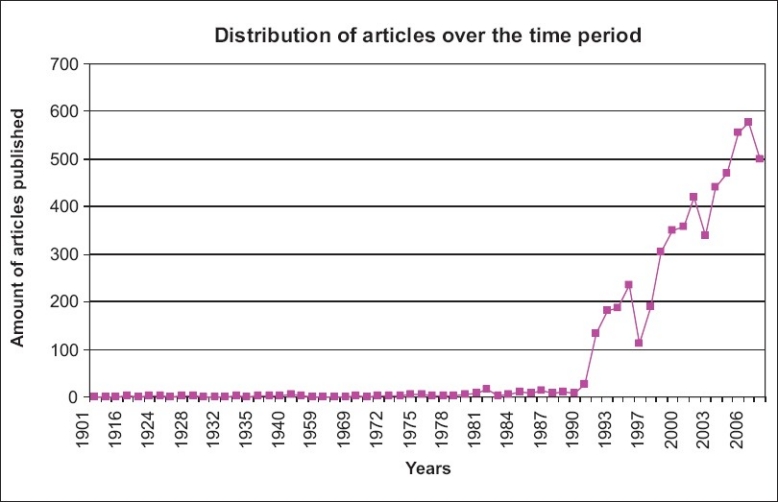
Publications related to depression and suicide in the Web of Science database 1900 to 2007
Journals
We compared the amount of publications by the different journals. As a measure of quality, we compiled a report of the average citation rates of the top 15 of these journals, and created a graph that shows the amount of publications by each of these journals as well as their average citation rates [Figure 2].
Figure 2.
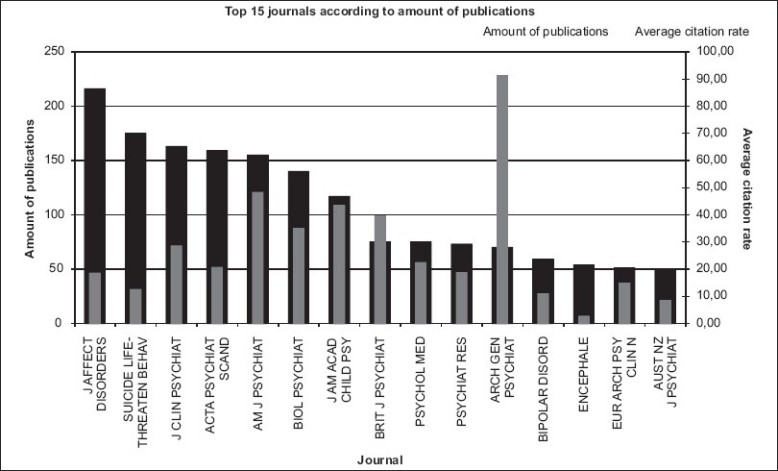
Comparison of the amount of papers published by each journal and the average number of citations per journal as an indication of the quality of the publications
The journal that published most papers during this time period was the “Journal of affective disorders” (216), followed by the Journal “Suicide and Life Threatening Behaviour” (175) and the “Journal for clinical Psychiatry” (163). The American journal of Psychiatry had the highest amount of citations (7476), followed by the Journal “The Archives of general Psychiatry” (6385 citations). When comparing the amount of publications with the amount of citations per publication, the Journal that published papers with the highest average citation rate was “The Archives of General Psychiatry.” Seventy papers were published, with an average citation rate of 91.21. The other Journals that also had high average citation rates were the American journal of Psychiatry (48,23), the Journal of the American Academy of Child Psychiatry (43,44), and the British Journal of Psychiatry (39,55).
Authors
The authors, who published papers relating to depression and suicide according to the WoS from 1900 to 2007, were compared. In the comparison of the amount of papers published per author, 13 441 authors were found. Of these, 99.8% (13 410) published 20 or less papers in this time-period, with three authors (Mann JJ, Oquendo MA, and Conwell Y) each publishing more than 50 papers.
A graph was compiled comparing the 15 authors who published the most papers on this subject with the h-index for each author [Figure 3]. Using these tools, the quality of the publications for the different authors can be compared. Mann JJ published most papers on this subject (118) and has the highest h-index of the authors, with 39. There were four other authors (Oquendo MA, Brent DA, Meltzer HY, and Avago V) who each had an h-index above 20.
Figure 3.
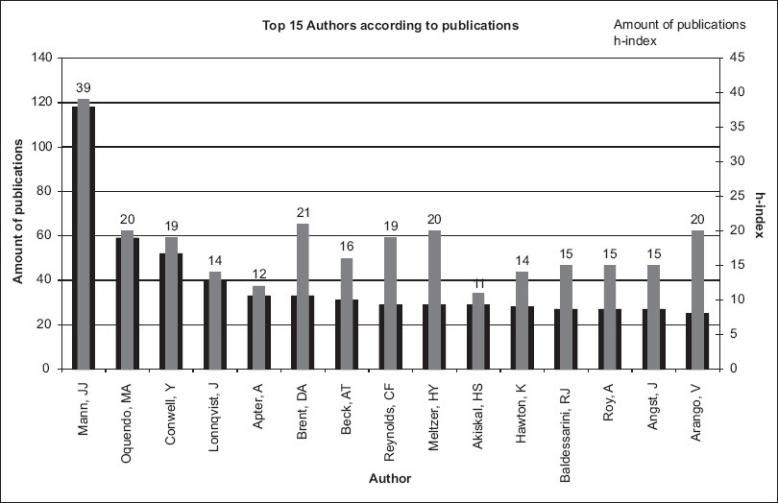
A comparison of the 15 authors who published most papers with the h-index of each author
As a measure of the cooperation between the authors who published more than 20 papers each, a graph was compiled to show the cooperation between these authors [Figure 4]. The two authors who wrote most papers together were Mann JJ and Oquendo MA (57 papers). They also each cooperated with eight other authors. Sher L and Zalsman G each cooperated with six other authors, including each other. Of the authors who have h-indexes above 20, only Meltzer HY does not appear in Figure 4.
Figure 4.
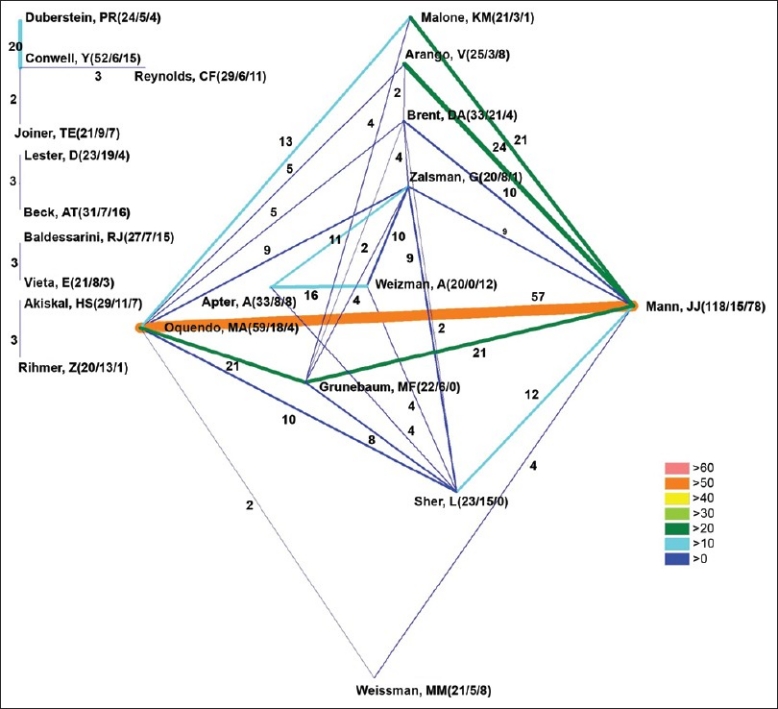
A comparison of the cooperation between authors who published more than 20 papers Format: Author name (amount of publications/amount of publications first author/amount of publications last author or coordinator)
Origin
The total amount of publications on depression and suicide between 1900 and 2007 according to the WoS came to 6 069, of which 2 939 were published by workgroups based in the USA, 585 in the United Kingdom, 388 in Canada, and 305 in Germany. The other 63 countries published the other 30% of the total amount of publications. Using Density-equalizing mapping, a map of the world according to the amount of publications per country can be seen in Figure 5, while Table 1 shows the 10 countries that published most papers on this topic.
Figure 5.
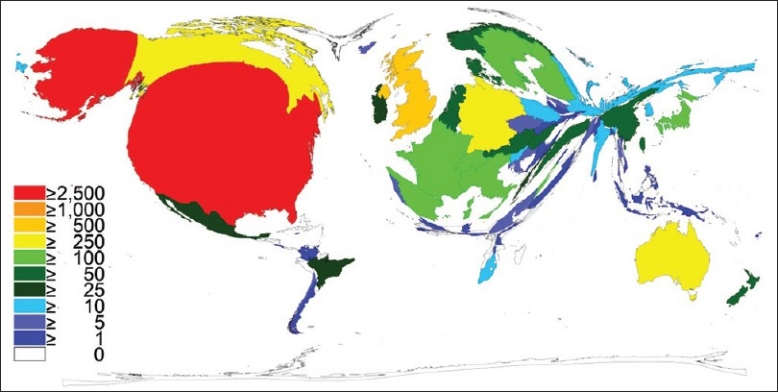
Density equalizing map illustrating the number of publications in each country. The area of each country was scaled in proportion to its total number of publications regarding depression and suicide
Table 1.
Amount of papers published per country, of the top 10 publishing countries
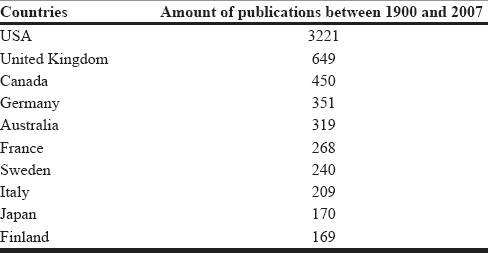
In order to see if the GDP and PPP of the countries had any influence on the amount of publications by those countries, SPPS 17.0 was used to see if there is a correlation between the amount of publications and the GDP and PPP of these countries. The result showed a significant correlation (r=0.753, P=0.01). SPPS 17.0 was also implemented to see if there was a correlation between the population of a country and the amount of publications. We found that there was no correlation (r=0.183, P=0.01).
In assessing the amount of cooperation between the different countries of origin, Figure 6 was compiled, showing the cooperation between countries that cooperated in publishing at least 10 papers together. We found that there is a lot of cooperation between the USA and Canada (60 publications), as well as the USA and the United Kingdom (45 publications) on this topic. When taking the amount of cooperation-papers as a percentage of the amount of publications by that country, Italy has the highest percentage at 48.6%, compared with other countries which copublish a lot (Canada, 32.7%; Germany, 26.3%; UK, 25.2%; and USA, 14.5%). One has to keep in mind that the four latter countries each published at least three times the total amount of papers that Italy published in this time period.
Figure 6.
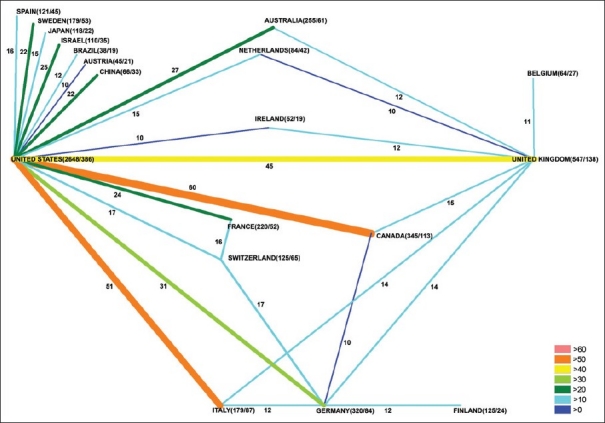
A comparison of countries that cooperated in publishing more that 10 papers. Format: country (amount of publications/amount of publications in cooperation with other countries)
The comparison of male and female suicide rates of the G8 countries[23] with the amount of publications and the amount of cooperation with other countries can be seen in Table 2. Of note is that although Russia had the highest male suicide rate (70.6 per 100 000) and the second highest female suicide rate (36.5 per 100 000) of the G8 countries in 1999, they only published nine publications on this topic in this time period, of which two were in cooperation with other countries. In comparison, Japan, which had the second highest male suicide rate (36.5 per 100 000) and the highest female suicide rate (14.1 per 100 000) of the G8 countries in 1999, published 145 papers in this time period of which 22 were in cooperation with other countries.
Table 2.
Comparison of the G8 countries according to male suicide rate in 1999 (except Canada for 1998)

DISCUSSION
In the current study, bibliometric data for the search terms “suicide and depression” were collected from the available world literature. We found that publications on this subject have been increasing since 1990. We also found that there are discrepancies between the amount of papers published by authors and the h-indexes of these authors. A similar discrepancy was found between the journals that published most papers and their average citation rates. In a comparison of the G8 countries, we found that some countries had few publications, despite having high suicide rates.
The abovementioned increase in publications can be explained by the fact that the ISI database records inserted past 1990 also contain the abstract in which the exploration algorithm searches. This results in more publications being found when searching for a phrase.[24] The advances of the internet after 1990 with the tendency to cheaper and more comfortable means of communications might serve as a further explanation.[25]
In 1963, de Sola and Prince published a theory claiming that the amount of scientific output will double every 10 to 15 years.[26] We found that the increase in publications on depression and suicide increased with a gradient of m=34,4 from 1990 to 2006. This indicates a much higher increase than a double increase over these 16 years, disproving this theory.
An increase in publications since 1990 has also been shown in similar research on psoriasis[27] and rheumatoid arthritis.[28] In a comparison of the amount of publications from 1990 to 2006 between depression and suicide, psoriasis and rheumatoid arthritis, we found that the gradient of increase for depression and suicide publications is lower than that of psoriasis (m=50,1) and that of rheumatoid arthritis (m=211,8) ([Figure 7] for the comparison).
Figure 7.
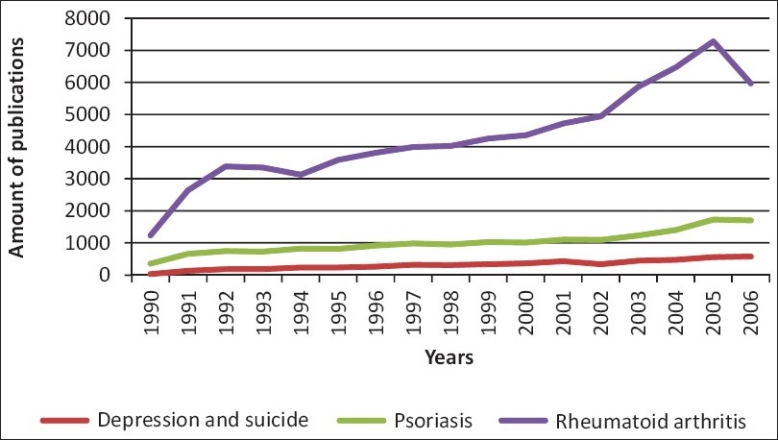
A comparison of the amount of publications from 1990 to 2006 between the subjects “depression and suicide,” “psoriasis,” and “rheumatoid arthritis”
From this, we conclude that although there was an increase in publications on depression and suicide since 1990, there was a higher interest in psoriasis and in rheumatoid arthritis than in depression and suicide during this time period. This variation in interest between different subjects can be attributed to funding discrepancies between different diseases, as was found in a study comparing funding of cardiovascular and respiratory diseases in Germany.[29]
We also found discrepancies between the amount of papers published by different journals and their average citation rates. We found that the journals that published most papers did not have the highest average citation rates [Figure 2]. This could indicate that the journals with the high average citation rates published more general papers that had a higher impact and were therefore read by more people. The lower average citation rates of the other journals could be due to more subject-specific publications that were read by less people and therefore cited less.
In the comparison of the citation rates of the different authors, we found that the authors who published most papers and had the highest citation rates (Mann JJ and Oquendo MA) were also the authors who cooperated most with other authors. As these authors are both from the same institution (the New York State Psychiatric Institute and Hospital), this would indicate that this institution publishes papers that are read by a lot of people.
As some of the authors who had high h-indexes in Figure 3 do not appear in the graph comparing cooperation between authors [Figure 4], this indicates that these authors cooperated with less than two other authors in their publications. This would indicate that these authors tend to work on their own or in small workgroups. Although it would be good for all authors to cooperate with each other, some authors might profit from not cooperating due to personal reasons. The fact that these authors are still cited a lot indicates that their research is being read by a lot of people.
The subject of cooperation also came to the forefront in the comparison of countries. We found that the countries that published most papers also cooperated most with each other. This could be explained by the fact that these countries, the USA, Canada, and the United Kingdom, are all English-speaking countries. Other reasons could be traditional cooperation between these countries or scientists who emigrated from one country to another.
The fact that there was a correlation between the GDP and PPP of the countries that published a lot of papers indicates that the developed countries of the world are publishing more papers on this subject than the developing countries. This is also clear from the density equalizing map [Figure 5], where the developing countries of the World in South America, Africa, and the Asian subcontinent clearly produce fewer publications on this subject.
One exception to this finding is Russia. Russia is the only country of the G8 countries that does not appear in Figure 6 (Amount of cooperation between countries). It is significant that Russia had the highest male suicide rate of the G8 countries in 1998/1999 [Table 2], but published the least papers and cooperated less with other countries when publishing papers on this topic. The high suicide rate in Russia has been linked with heavy alcohol consumption in Russia according to data from the post-Soviet era.[30] The finding that Russia publishes few papers could be attributed to traditional reduced cooperation with the West dating back to the time of the Soviet Union, as a reduction in publications has also been found in similar scientometric research in basic and applied sciences.[31]
Competing interests
The authors declare that they have no competing interests.
Authors’ contributions
DAG and BHV designed the study. CS and BHV constructed the different graphs and did the data analysis. BHV did the research and wrote the paper. DQ assisted in the layout and evaluation of the paper. DAG coordinated the project.
ACKNOWLEDGMENTS
The authors want to thank the staff at the Institute of Occupational medicine at the Charité medical University, the Humbolt University, and the Free University in Berlin.
Footnotes
Source of Support: Nil
Conflict of Interest: None.
REFERENCES
- 1. [Last accessed on 2011 May 19]. Available from: http://www.cnn.com/SPECIALS/2001/memorial/
- 2. [Last accessed on 2011 May 19]. Available from: http://www.who.int/mental_health/en/
- 3.Palmer C, Revicki D, Halpem M, Hatziandreu E. The cost of suicide and suicide attempts in the United States. Clin Neuropharmacol. 1995;18:25–S33. [Google Scholar]
- 4.Thacker SB, Stroup DF, Carande-Kulis V, Marks JS, Roy K, Gerberding JL. Measuring the public's health. Public Health Rep. 2006;121:14–22. doi: 10.1177/003335490612100107. [DOI] [PMC free article] [PubMed] [Google Scholar]
- 5.Knox KL, Caine ED. Establishing Priorities for Reducing Suicide and Its Antecedents in the United States. Am J Public Health. 2005;95:1898–903. doi: 10.2105/AJPH.2004.047217. [DOI] [PMC free article] [PubMed] [Google Scholar]
- 6.Reducing Suicide: A National Imperative. Washington, DC: National Academy Press; 2002. Committee on Pathophysiology and Prevention of Adolescent and Adult Suicide, Board on Neuroscience and Behavioral Health, Institute of Medicine. [Google Scholar]
- 7.Rockville, MD: US Dept of Health and Human Services; 2003. New Freedom Commission on Mental Health, Achieving the Promise: Transforming Mental Health Care in America. Final Report. Pub. No. SMA-03-3832. [Google Scholar]
- 8.Kaplan HI, Sadock BI, Grebb IA. 7th ed. Maryland, USA: Williarns and Wilkins; 1994. Synopsis of Psychiatry, Behavioural Sciences, Clinical Psychiatry; p. 805. [Google Scholar]
- 9.Kaplan HI, Sadock BI, Grebb IA. 7th ed. Maryland, USA: Williarns and Wilkins; 1994. Synopsis of Psychiatry, Behavioural Sciences, Clinical Psychiatry; p. 531. [Google Scholar]
- 10.Canavangh JT, Carson AJ, Sharpe M, Lawrie SM. Psychological autopsy studies of suicide: A systematic review. Psychol Med. 2003;33:395–405. doi: 10.1017/s0033291702006943. [DOI] [PubMed] [Google Scholar]
- 11. [Last accessed on 2011 May 19]. Available from: http://www.who.int/classifications/icd/icdonlineversions/en/index.html .
- 12. [Last accessed on 2011 May 19]. Available from: http://www.dsmivtr.org/
- 13.Hawton K, Van Heeringen K. Suicide. Lancet. 2009;373:1372–81. doi: 10.1016/S0140-6736(09)60372-X. [DOI] [PubMed] [Google Scholar]
- 14.Hawton K, Sutton L, Haw C, Sinclair J, Harriss L. Suicide and attempted suicide in bipolar disorder: A systematic review of risk factors. J Clin Psychiatry. 2005;66:693–704. doi: 10.4088/jcp.v66n0604. [DOI] [PubMed] [Google Scholar]
- 15.Hawton K, Sutton L, Haw C, Sinclair J, Deeks JJ. Schizophrenia and suicide: A systematic review of risk factors. Br J Psychiatry. 2005;187:9–20. doi: 10.1192/bjp.187.1.9. [DOI] [PubMed] [Google Scholar]
- 16.Sevnic A. Multilingual approach to “Web of Science”. J Natl Med Assoc. 2005;97:116–7. [PMC free article] [PubMed] [Google Scholar]
- 17.Sevnic A. Web of science: A unique method of cited reference searching. J Natl Med Assoc. 2004;96:980–3. [PMC free article] [PubMed] [Google Scholar]
- 18.Hirsch JE. Does the h-index have predictive power? Proc Natl Acad Sci USA. 2007;104:19193–8. doi: 10.1073/pnas.0707962104. [DOI] [PMC free article] [PubMed] [Google Scholar]
- 19.Gastner MT, Newman ME. From the cover: Diffusion-based method for producing density-equalizing maps. Proc Natl Acad Sci USA. 2004;101:7499–504. doi: 10.1073/pnas.0400280101. [DOI] [PMC free article] [PubMed] [Google Scholar]
- 20. [Last accessed on 2011 May 19]. Available from: http://www.imf.org/external/pubs/ft/weo/faq.htm .
- 21. [Last accessed on 2011 May 19]. Available from: http://siteresources.worldbank.org/DATASTATISTICS/Resources/GDP.pdf .
- 22. [Last accessed on 2011 May 19]. Available from: http://www.who.int/whosis/en/index.html .
- 23. [Last accessed on 2011 May 19]. Available from: http://www.who.int/mental_health/prevention/suicide/suiciderates/en/
- 24. [Last accessed on 2011 May 19]. Available from: http://images.isiknowledge.com/WOK46/help/WOS/h_database.html#ssci .
- 25.Glowniak J. History, structure, and function of the Internet. Semin Nucl Med. 1998;28:135–44. doi: 10.1016/s0001-2998(98)80003-2. [DOI] [PubMed] [Google Scholar]
- 26.De Sola, Prince D. Frankfurt AM: Suhrkamp; 1974. Little Science, Big Science. [Google Scholar]
- 27.Schöffel N, Mache S, Al-Mutawakel K, Quarcoo D, Scutaru DA, Groneberg DA, et al. A new view on psoriasis research efforts. J Eur Acad Dermatol Venereol. 2010;24:85–8. doi: 10.1111/j.1468-3083.2009.03293.x. [DOI] [PubMed] [Google Scholar]
- 28.Schöffel N, Mache S, Quarcoo D, Scutaru C, Vitzthum K, Groneberg DA, et al. Rheumatoid arthritis: Scientific development from a critical point of view. Rheumatol Int. 2010;30:505–13. doi: 10.1007/s00296-009-1005-5. [DOI] [PubMed] [Google Scholar]
- 29.Groneberg-Kloft B, Kreiter C, Welte T, Fischer A, Quarcoo D, Scutaru C. Interfield dysbalances in research input and output benchmarking: visualisation by density equalising procedures. Int J Health Geogr. 2008;7:48. doi: 10.1186/1476-072X-7-48. [DOI] [PMC free article] [PubMed] [Google Scholar]
- 30.Pridemore WA. Heavy drinking and suicide in Russia. Soc Forces. 2006;85:413–30. doi: 10.1353/sof.2006.0138. [DOI] [PMC free article] [PubMed] [Google Scholar]
- 31.Groneberg-Kloft B, Scutaru C, Kreiter C, Kölzow S, Fischer A, Quercoo D. Institutional operating Figures in basic and applied sciences: Scientometric analysis of quantitative output benchmarking. Health Res Policy Syst. 2008;6:6. doi: 10.1186/1478-4505-6-6. [DOI] [PMC free article] [PubMed] [Google Scholar]


